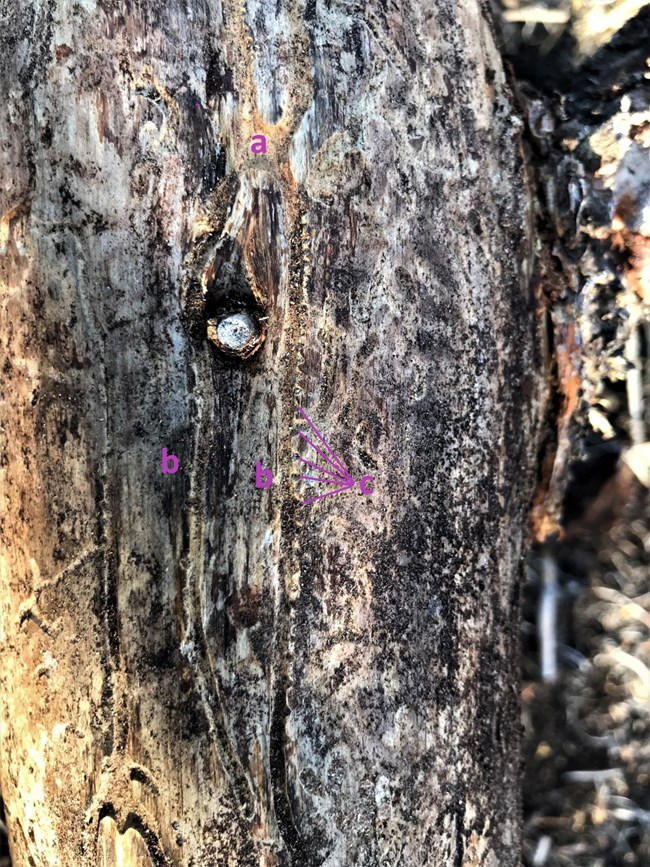Part of a series of articles titled The Midden - Great Basin National Park: Vol. 21, No. 2, Winter 2021.
Article
Cool Bug Facts: The Pinyon and The Engraver
This article was originally published in The Midden – Great Basin National Park: Vol. 21, No. 2, Winter 2021.
By David Greene, Biological Science Technician
The pinyon engraver beetle (Ips confusus) is a member of the Bark Beetle subfamily Scolytinae. These native beetles play an important role in pinyon-juniper forests by killing weak or damaged pinyon pine trees. This can improve habitat diversity, create canopy gaps allowing shade intolerant species in the seed bank to germinate, provide snag habitat, and contribute organic material to the soil, not to mention the beetles themselves are a part of the food web.
The beetles cause tree mortalities by boring into the living tissues of the cambium layer just below the bark. They feed on xylem and phloem, disrupting the transportation and storage of water, nutrients, and sugar. Under normal circumstances, most healthy pinyons are not at risk of Ips infestations. However, beetle population booms, drought, comorbid fungal infections, or a combination of these can lead to an increased risk of infestation, even in healthy trees.
The pinyon engraver beetle (Ips confusus) is a member of the Bark Beetle subfamily Scolytinae. These native beetles play an important role in pinyon-juniper forests by killing weak or damaged pinyon pine trees. This can improve habitat diversity, create canopy gaps allowing shade intolerant species in the seed bank to germinate, provide snag habitat, and contribute organic material to the soil, not to mention the beetles themselves are a part of the food web.
The beetles cause tree mortalities by boring into the living tissues of the cambium layer just below the bark. They feed on xylem and phloem, disrupting the transportation and storage of water, nutrients, and sugar. Under normal circumstances, most healthy pinyons are not at risk of Ips infestations. However, beetle population booms, drought, comorbid fungal infections, or a combination of these can lead to an increased risk of infestation, even in healthy trees.

NPS Photo by G. Baker
Water stress (i.e., drought) can compromise the effectiveness of the pitch tube defense, requiring less effort from the beetle for a successful infestation. Furthermore, slash left over from logging or thinning can provide a surplus of habitat for beetle populations to flourish. Pinyon engraver population booms can overwhelm even healthy trees, and often lead to widespread pinyon mortalities.
If a beetle successfully bores into a pinyon, the sap that was once deployed as a defense now plays a role in attracting more beetles. The pinyon engraver bio-oxidizes terpenes present in the sap to produce pheromones signaling the location of a suitable host, which in turn draws free-flying beetles en masse to join the attack. As the number of beetles colonizing the ill-fated pinyon grow, so does the strength of the pheromone signal. Depending on environmental conditions and signal strength, some Ips species can detect and respond to this call from over eleven miles away.

NPS Photo by David Greene
In the egg galleries, the female will etch around 20 to 30 small niches (Figure 2c) where a single egg, packed in with debris, is laid. The eggs normally hatch after seven days. The larvae pupate after three to six weeks and emerge from the tree as adults, then follow the pheromone trail to The Midden 7 the next potential host tree where the cycle starts again. The year’s first generation normally emerge in April or May, depending on temperatures. It is common for the pinyon engraver to produce three to four generations a year. Adults overwinter in the tree in sinuous feeding galleries.
Pinyon juniper woodlands’ range spans across five states in the Southwestern United States. Within that range, around 15% of the land is occupied by the woodlands and play an ecological important role in the Great Basin region. At Great Basin National Park, pinyon juniper woodlands cover about 7000 acres or 10% of park lands. Drought conditions and increased temperatures due to climate change are predicted for the future, and we should expect to see ecosystems respond. The Park will likely see more evidence of pinyon engravers and impacts to pinyon pine woodlands in the years to come.
Last updated: February 7, 2024
